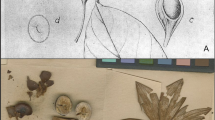Abstract
Temnocephalida includes species demonstrating many intermediate steps presenting the transition from commensalism to parasitism. Dramatic morphological changes also occurred within this group but the number of supraspecific taxa is small, making the Temnocephalida an excellent model for evolutionary studies. Having summarised original and relevant published morphological data, we suggest a cladogram (phylogenetic tree) which nearly fully resolves the order of branching of families and main genera within the Temnocephalida. We also introduce a new family, the Diceratocephalidae nov. fam.
Similar content being viewed by others
References
Baer, J. G., 1953. Zoological results of the Dutch New Guinea Expedition 1939. No. 4. Temnoécphales. Zool. Meded. 23: 119–139.
Cannon, L. R. G., 1991. Temnocephalan symbionts of the freshwater crayfish Cherax quadricarinatus from nothern Australia. Hydrobiologia 227: 341–347.
Cannon, L. R. G. & K. B. Sewell, 1995. Craspedellinae Baer, 1931 (Platyhelminthes: Temnocephalida) ectosymbionts from the branchial chamber of Australian crayfish (Crustacea: Parastacidae). Mem. Queensland Mus. 38: 397–418.
Iomini, C., M. Ferraguti, G. Melone & J.-L. Justine, 1994. Spermiogenesis in a Scutariellid (Platyhelminthes). Acta zool. (Stockholm) 75: 287–295.
Joffe, B. I., 1981a. Morphology and phylogenetic relations of the Temnocephalida (Turbellaria). Zool. Zh. 60: 661–672 (in Russ.).
Joffe B. I., 1981b. Morphology of temnocephalids and morphological alterations during the transition to parasitism in the Platyhelminthes. Parazitologiya (St Petersburg) 15: 209–218 (in Russian).
Joffe, B. I., 1982. The temnocephalids: their morphology and phylogeny. PhD thesis, Zoological Institute RAS, St Petersburg: 1–227 (in Russian).
Joffe, B. I. 1987. On the evolution of the pharynx in flatworms. Proc. zool. Inst. RAS 221: 34–71 (in Russian).
Joffe, B. I., 1988. On the phylogeny of the Temnocephalida. Fortschr. Zool./Progress in Zool. 36: 59–62.
Joffe B. I. and R. A. Janashvili, 1982. First finding of temnocephalids (Turbellaria: Scutariellidae) at the territory of the USSR. Parasitologya (St Petersburg) 15: 170–174 (in Russian).
Joffe B. I. & L. R. G. Cannon, 1998. The organisation and evolution of the mosaic of the epidermal syncytia in the Temnocephalida (Plathelminthes). Zool. Anz. 237: 1–14.
Joffe B. I., I. V. Solovei & L. R. G. Cannon, 1995a. The structure of the epidermis in Didymorchis (Temnocephalida, Platyhelminthes). Aust. J. Zool. 43: 631–641.
Joffe B. I., I. V. Solovei, K. B. Sewell & L. R. G. Cannon, 1995b. The organisation of the epidermal syncytial mosaic in Diceratocephala boschmai (Temnocephalida, Platyhelminthes). Aust. J. Zool. 43: 509–518.
Joffe, B. I., I. V. Solovei & L. R. G. Cannon, 1996. The posttentacular syncytia of temnocephalids: the first indication of putative osmoregulatory organ in the epidermis of a platyhelminth. Acta zool. (Stockholm) 77: 241–248.
Joffe, B. I., I. V. Solovei, N. A. Watson & L. R. G. Cannon, 1997. Structure and evolution of the pharynx in the Temnocephalida (Platyhelminthes). Can. J. Zool. 75: 205–226.
Justine J.-L., 1991. Phylogeny of parasitic Platyhelminthes: a critical study of synapomorphies proposed on the basis of ultrustructure of spermiogenesis and spermatozoa. Can. J. Zool. 69: 1421–1439.
Rohde, K. & N. A. Watson, 1990. Epidermal and subepidermal structures in Didymorchis (Platyhelminthes, Rhabdocoela). I. Ultrastructure of epidermis and subepidermal cells. Zool. Anz. 224: 263–275.
Sewell K. B. & L. R. G Cannon, 1995. A scanning electron microscope study of Craspedella sp. from the branchial chamber of redclaw crayfish, Cherax quadricarinatus, from Queensland, Australia. Hydrobiologia 305: 151–158.
Sewell K. B. & I. D. Whittington, 1995. A light microscope study of the attachment organs and their role in locomotion of Craspedella sp. (Platyhelminthes: Rhabdocoela: Temnocephalidae), an ectosymbiont from the branchial chamber of Cherax quadrcarinatus (Curstacea: Parastacidae) in Queensland, Australia. J. nat. Hist. 29: 1121–1141.
Sewell, K. B. & L. R. G. Cannon, 1998. The taxonomic status of the ectosymbiotic flatworm Didymorchis paranephropis Haswell, 1900. Mem. Queensland Mus. 42: 585–595.
Watson, N. A. & K. Rohde, 1995. Ultrastructure of spermiogenesis and spermatozoa in the platyhelminths Actynodactylella blanchardi (Temnocephalida, Actinodactylellidae), Didymorchis sp. (Temnocephalida, Didymorchidae), and Gieysztoria sp. (Dalyelliida, Dalyelliidae), with implications for the phylogeny of the Rhabdocoela. Invert. Repr. Dev. 27: 145–158.
Williams, J. B. 1979. Studies on the epidermis of Temnocephala. IV. Observations on the ultrastructure of the epidermis of Temnocephala dendyi, with notes on the role of Golgi apparatus in autolysis. Aust. J. Zool. 27: 483–499.
Author information
Authors and Affiliations
Rights and permissions
About this article
Cite this article
Joffe, B., Cannon, L.R.G. & Schockaert, E.R. On the phylogeny of families and genera within the Temnocephalida. Hydrobiologia 383, 263–268 (1998). https://doi.org/10.1023/A:1003438321560
Issue Date:
DOI: https://doi.org/10.1023/A:1003438321560




